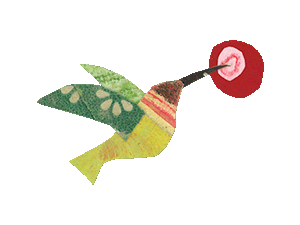A Simple Technique To Create Lasting Stories
Stories open a child’s imagination not just to far away lands, but to real and palpable places in your home and neighborhood. They can make common places sparkle with new meaning. That’s what this technique is all about - weaving stories into place, so places weave us into stories.
Here’s How It Works:
Find a place that you and your child frequent
Give it a name
Tell a story that involves this name
Whether you live in a city or on a dusty dirt road, there are lots of places that you and your child frequent. We usually call these places the park, the library bench, the intersection of so and so, or the old tree by the creek. They can be corners in your house, the basement, or even your couch. Everything is a place.
By giving that place a name, you give it a life of its own. It’s like naming a child’s favorite stuffy. A name makes it familiar, comfortable, close. It’s not just any stuffed dog anymore - it’s Rosie! We can do the same thing with places, and kids take to it easily. It can even be a great way to help them orient in what is sometimes a big and chaotic world.
It’s a good idea to start with one place, but over time you and your kids might name and develop stories for several prominent spots. The names help them instantly recollect the place and develop a rich sensory map of their world. And since each place brings a story to mind, just seeing it or thinking about it gives them lots of room to explore, create, and play - and also lots of fond memories for the two of you.
Here’s An Example
Near our house there is a quiet dirt road. We walk it with frequently with our dog, and the kids. The road ends at a paved street, which has become our turn around spot. We could just call it the end of the road, but long ago we noticed that someone had put up a yellow sign with a silhouette of a moose and the word “xing.” Moose Crossing became its name, even though there’s no moose within a hundred miles. Now it’s a place to go to, a destination.
Did I ever tell you what happened at Moose Crossing? Well, one day there was a skunk, and while there aren’t any moose at Moose Crossing, there are most definitely skunks. This skunk was very proud and very beautiful, so he brushed and cleaned his tail every day. He liked to show it off. Well, one day ol’ badger stole his brush and hid it under one of these bushes. Skunk is still looking for it today.
Stories like this are very simple, but they make a place come alive. It plants a story in the earth. It’s the same thing that makes a toy come alive. Children bore of doodads fairly quick, but if there’s a story inside it - it can become a lifelong friend. If you’re a goofball like us, you might even sneak a real brush under the bushes one day and let your child find it.
The Story and the Place Don’t Have to Be the Same Thing
Here’s another example. A mother and her child have a favorite place at the park by some bushes. The child runs off and plays on the swings, but it’s the spot the two of them always return to. “This is like our little nest,” Mom says one day. “I think I’m going to call this place The Bird’s Nest.”
The child likes it, and soon the name grows common. One day when the family is at home, Mom tells a short story about “The Bird’s Nest.” There’s a Mama and Papa Bird who love to take their little one on long flights around the city. They see many things, but they always come back to The Bird’s Nest.
A few days later, Mom and child are at the park again. As soon as little one sees The Bird’s Nest, he says, “Tell me the story about the Bird’s Nest!” The place contains the story. The name makes it memorable. Mom retells it briefly, and the two spend the day flying all over the “city” in the park.
Stories Can Live in Objects Too
This technique is based on what we call The Storytelling Loop. It works great for places, but you can plant a story in almost anything - a doll, a celery stick, or even an activity. Stories help children get creative and engage with real objects. They catch our fancy and make things interesting. And they can be very simple.
Over time, you can imagine what a child sees when he visits places and objects that remind him of all these wonderful stories. The whole world lights up for such a child. It’s such a creative and vivid place. And every moment reminds him of you.
--
Photo by James Wheeler on UnSplash

